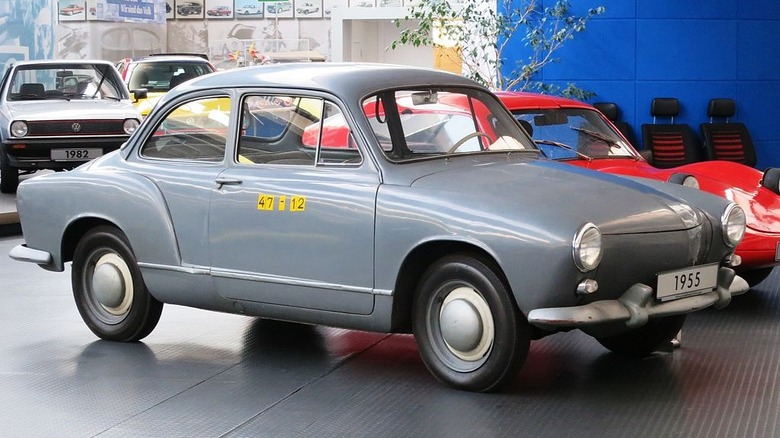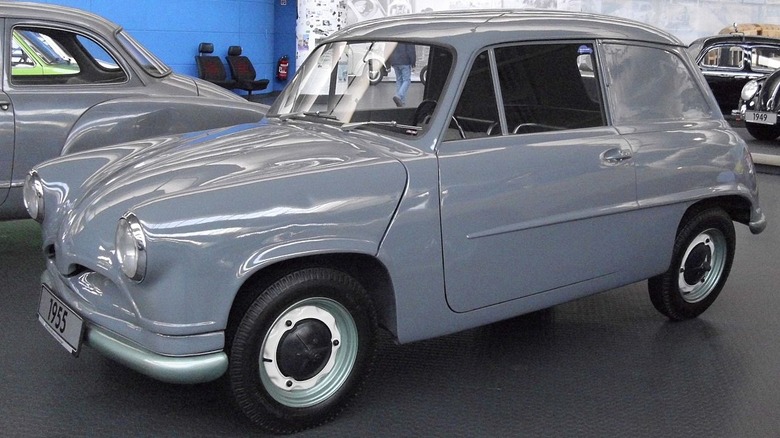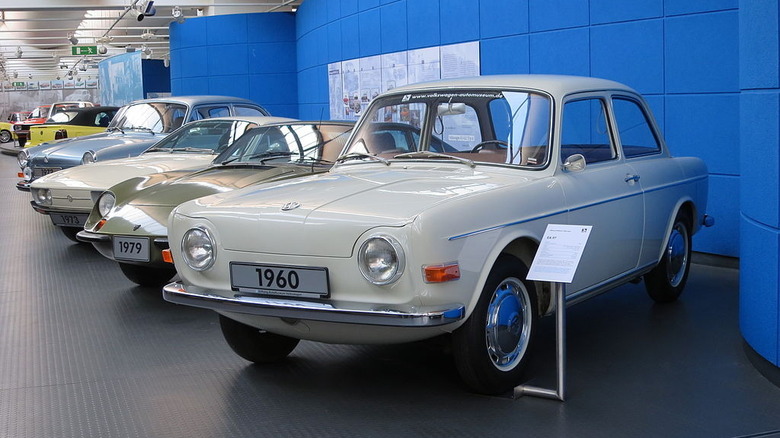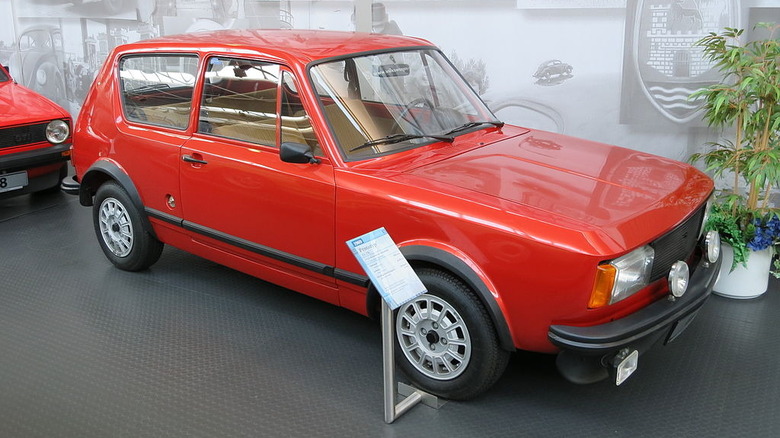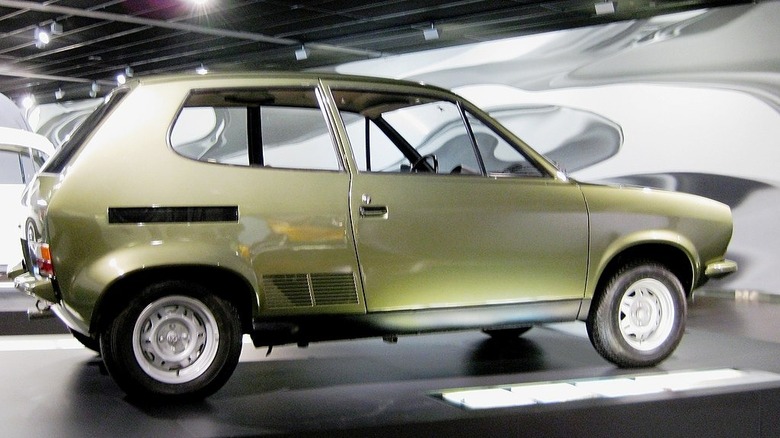5 Volkswagen Designs That Nearly Replaced The Legendary Beetle
When Adolph Hitler first tapped Ferdinand Porsche in the 1930s to build the Kraft durch Freude (KdF) Wagen, or the Strength through Joy Car (aka the Beetle), there was no way of knowing that something associated with one of the worst people in human history would go on to become so iconic and beloved by the world.
Hitler wanted an inexpensive car German citizens could afford – a volks wagen, a "People's Car." His vision was to have thousands of these shiny cars zipping along the autobahn to show that Germany had crawled back from the devastation of World War I and was once again a strong, unified nation. Then World War II started.
By then, Volkswagen had built approximately 600 cars, but as soon as the war began, civilian production ceased, and every one that rolled off the assembly line went straight into military use. Hitler himself received the first convertible. Civilian production resumed shortly after the war ended (in 1945), and by the end of 1946, more than 10,000 had been made.
In 1949 it finally made it to America, and in August 1955, Volkswagen produced its one-millionth Bug. In 1972, it became the world's most-produced car ever. When all was said and done, 21,529,464 had been sold during its production run. But as far back as the early 1950s, VW looked at replacing the wildly popular Beetle. Here are five of the more than 70 designs considered as the heir apparent.
1955/56 EA47-12
If there was a first proper replacement for the Beetle, it was the EA47-12. The number twelve designates it was the 12th of 15 prototypes built between 1953 and 1956, while the "EA" stands for Entwicklungsauftrag, meaning "development order."
Since Volkswagen had no in-house coachbuilding team, they relied heavily on outside companies. In this case, they used Italian designer Ghia (of Karmann Ghia) to build a more elongated body than the Beetle's and looked more like a conventional compact car.
The rear-mounted 1.2-liter 72.7 cubic inch air-cooled boxer powerplant had only four cylinders, produced 30 horsepower, and maxed out at 50 miles per hour. However, it did include what was at the time some very sophisticated high-end equipment, including torsion bar rear suspension, a transverse link front axle, and a fully synchronized 4-speed gearbox.
Ultimately, VW did not put this car into production as it was more interested in returning profits to the company to expand its dealer network and improve production facilities.
[Image by Charles01 via Wikipedia | Cropped and scaled | CC BY-SA 4.0]
1955 EA48
Even more interesting is the EA48, which was in development around the same time as the EA47-12. Beetle sales weren't great, and VW wanted to roll out a smaller, cheaper car to help with overall finances. And, if VW had been quicker to pull the trigger on the EA48 would have beaten the now wildly popular British Mini Cooper to market (by a couple of years) and might have had a truly successful Beetle heir.
Before becoming fully self-sufficient, VW relied heavily on Porsche for both design and engineering ideas. The EA48 changed all that and became the first car wholly designed in-house without any assistance from Porsche. Built from the ground up, the E48 was made for casual city driving.
While a two-cylinder 700cc engine with a crank-mounted cooling fan was designed, VW used a 600cc with a belt-driven fan. This horizontally-opposed front-mounted 0.7-liter air-cooled flat-twin produced 18 horsepower and generated 29 pound-feet of torque with a top end of 60 mph.
The EA48 had a 4-speed manual transmission and unibody construction. What was groundbreaking was using a McPherson front suspension with front-wheel drive. Ironically, the EA48 never passed the prototype stage because by the time VW had a working prototype, sales of the Beetle had started to take off, and they feared it would detract from its sales numbers.
[Image by Buch-t via Wikimedia Commons | Cropped and scaled | CC BY 3.0]
1960 EA97
The development of this rear-engine prototype began in 1957 and didn't come to fruition until 1960. And while most (if not all) of these experimental Beetle replacements were one-offs, the EA97 was not one of them.
By all accounts, Volkswagen was highly pleased with its design and had its employees hand-build some 200 of these two-door sedans. In fact, it even gave the green light for a fully operational production line to be erected. The elongated, almost pontoon-shaped body was powered by a 1.1-liter 67.1 cubic inch opposed 4-cylinder and had a vast trunk in the front.
However, before the production line was even completed, VW decided it was too similar in class to the Beetle and the Type 3, which was also in development and subsequently released in 1961. So, VW changed its mind and shut down the whole project entirely.
Interestingly, more than a decade later, the EA97 would find its way back on the road — tangentially, at least. Strands of its DNA are said by some to be present within VW's Brasilia, a rear-engine compact vehicle designed and built entirely in Brazil and marketed for South America.
[Image by Charles01 via Wikimedia Commons | Cropped and scaled | CC BY-SA 4.0]
1969 EA276
In 1969 VW tried to get another potential Beetle replacement on the road, this one known as EA276. Far boxier than previous iterations, this one-off experimental prototype Volkswagen had the same opposed flat-four cylinder, air-cooled engine that powered the Beetle conventionally mounted in the front (unlike a Beetle), with a unibody hatchback design in the rear. Business up front, party in the back, as they say.
The 1.5-liter 91.1 cubic inch powerplant banged out 53 horsepower and generated 78 ft-lbs of torque.
Unlike most of the other 70-odd Entwicklungsauftrags, this front-wheel-drive hatchback actually went on to become something. In this case, it was the main inspiration for the Golf, which was indeed the rightful successor to the Beetle. During its development cycle, the Beetle's flat-four was replaced by the German automaker's more modern inline water-cooled I-4 engine.
While the Golf was released to the rest of the world in 1974, it took another year to make its way to the United States under an entirely different name — the Rabbit.
[Image by Charles01 via Wikimedia Commons | Cropped and scaled | CC BY-SA 4.0]
1969 EA266
The final attempt at replacing the iconic Beetle came with the EA266. It was also one of Heinrich Nordhoff's (Volkswagen's head) last projects before passing away in 1968. VW again teamed up with Porsche for its design. Instead of a front or rear-mounted engine, the two companies developed a "mid-engine" scheme that placed the water-cooled four-cylinder 1.6-liter engine longitudinally under the rear seat to save space.
This froggy-looking hatchback had some issues, not the least of which was that it was too expensive to build. The 1.6-liter engine put out 100 horsepower, making the vehicle difficult to handle. And because the "space-saving" engine was in such a weird spot, it not only required a 1.5-meter-long oil dipstick but was incredibly difficult to work on. Oh, and there was also the fact that fumes rose into the cabin, which warmed the behinds of backseat passengers.
Despite the car's obvious problems, Kurz Lotz (Nordhoff's successor) green-lit the EA266. The pilot project was about to begin in 1971 when Lotz was suddenly fired and replaced by Rudolf Leiding, who not only stopped the project but destroyed all but one (maybe two) of the 50 prototypes made. Not in any conventional way, either, mind you. He ran tanks over them.
VW lost five years of production time and some £300 million on the EA266.
[Image by Charles01 via Wikimedia Commons | Cropped and scaled | CC BY-SA 3.0]

